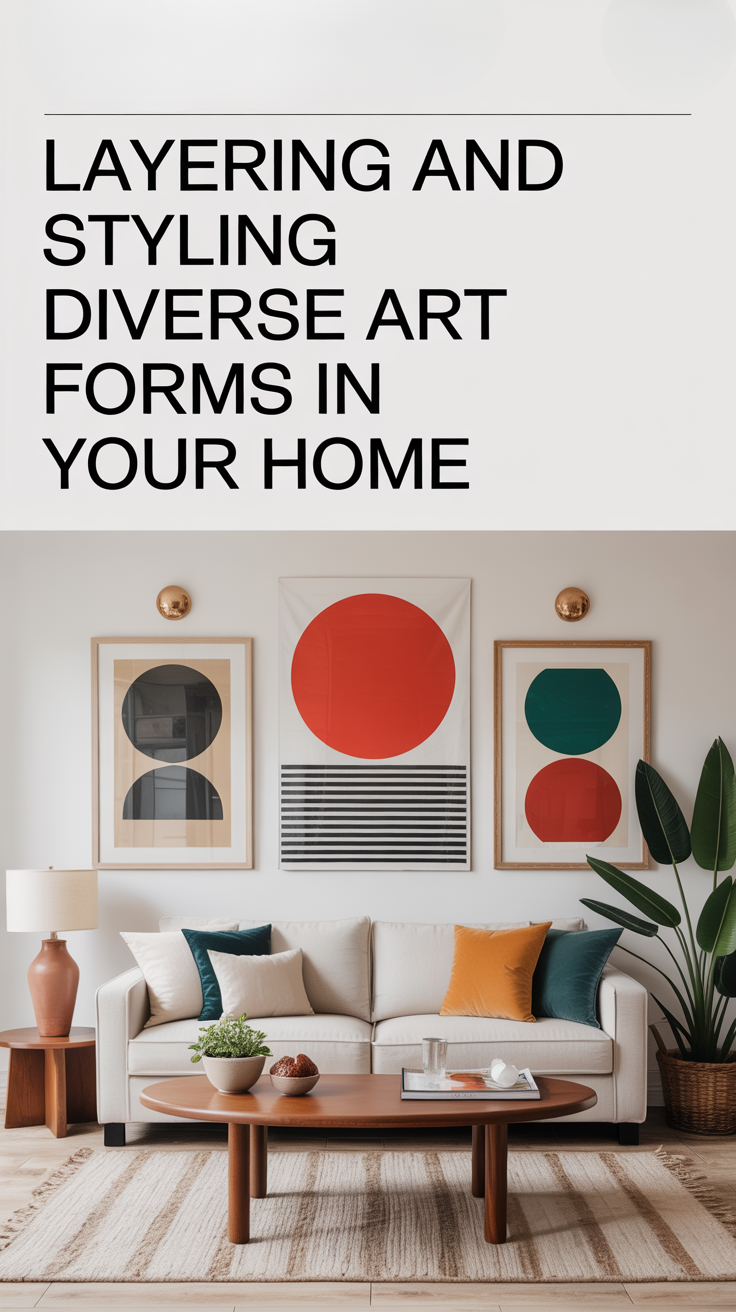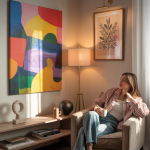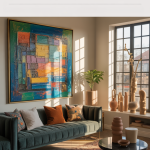The Art of Adornment: Layering and Styling Diverse Art Forms in Your Home
In an era where personal expression reigns supreme, our homes have transcended mere shelter to become canvases for our individuality. The once-dominant minimalist aesthetic, characterized by stark white walls and sparse decor, is gradually giving way to spaces that tell a story, evoke emotion, and reflect the unique journey of those who inhabit them. At the heart of this transformation lies the thoughtful integration of art. Far from being an afterthought, art is now recognized as a pivotal element in crafting interiors that feel both sophisticated and deeply personal.
Yet, for many, the prospect of styling art in their home remains a daunting one. How do you move beyond simply hanging a single piece on a wall to creating a layered, dynamic display that feels cohesive and intentional? How do you combine disparate art forms—from the delicate brushstrokes of a watercolor to the bold presence of a contemporary oil painting—without creating visual chaos? This article aims to demystify the art of adornment, offering practical insights and creative inspiration for layering and styling diverse art forms in your home. We’ll explore everything from the fundamental considerations of art care to advanced techniques for curating a collection that truly sings, transforming your living space into a personal gallery that evolves with you.
Understanding Your Art: Care and Display Considerations
Before jumping into the aesthetics of art styling, it’s crucial to understand the fundamental characteristics and care requirements of different art forms. Proper handling and display not only preserve the longevity and value of your pieces but also ensure they look their best in your home. The medium an artwork is created on—be it paper or canvas—significantly influences how it should be protected and presented.
A. Art on Paper (Prints, Watercolors, Drawings)
Artworks on paper, encompassing everything from delicate watercolors and intricate drawings to limited-edition prints and photographs, are often characterized by their fragility. These pieces are particularly susceptible to environmental factors such as light, humidity, and airborne pollutants. Therefore, their display requires careful consideration.
Framing is paramount for paper-based art. A well-chosen frame not only enhances the aesthetic appeal of the artwork but also provides a vital layer of protection. When selecting a frame, pay close attention to the glazing. Standard glass or acrylic offers basic protection, but for more valuable or cherished pieces, consider museum-quality glass. This specialized glazing often includes UV-filtering properties to prevent fading caused by sunlight and can also be non-reflective, minimizing glare and allowing for an unobstructed view of the artwork. The mat board used within the frame should also be acid-free to prevent discoloration or damage to the paper over time. For a more contemporary and less formal approach, especially with prints or posters, poster bars can offer a stylish alternative. These magnetic or clamp-style bars hold the artwork at the top and bottom, allowing it to hang freely, creating a relaxed yet chic display.
Regardless of the framing choice, avoiding direct, prolonged exposure to sunlight is a universal rule for paper art. Even with UV-protective glass, continuous exposure can degrade pigments and paper fibers. Position these pieces on walls that receive indirect light or in rooms where sunlight is less intense throughout the day. Monitoring humidity levels can also be beneficial, as extreme fluctuations can cause paper to buckle or warp.

B. Art on Canvas (Oil, Acrylic, Mixed Media)
Artworks created on canvas, such as oil paintings, acrylics, and many mixed media pieces, possess a different set of characteristics and care needs. These pieces are generally more robust than paper art but still require thoughtful consideration to maintain their integrity and appearance.
Unlike paper art, canvas paintings are typically displayed without glass. This is particularly true for oil paintings, which need to breathe; enclosing them behind glass can trap moisture and hinder the natural curing process of the paint, potentially leading to damage or discoloration. The artist often applies a protective varnish, which serves as the primary barrier against dust and environmental elements. While this direct exposure means you don’t have to worry about glass reflections, it does necessitate regular maintenance.
Care for canvas art involves gentle dusting with a soft, dry cloth to prevent buildup. If a painting becomes significantly dirty or damaged, it is always best to consult a professional art conservator. Attempting to clean or repair a valuable canvas piece yourself can lead to irreversible damage. Many canvas artworks come pre-framed by the artist, often in a ‘floater’ frame that creates a subtle shadow line around the canvas, enhancing its presence. If you wish to frame an unframed canvas or change an existing frame, seek out a professional framer experienced in handling paintings. They understand the nuances of different canvas types and painting techniques, ensuring the artwork is securely and appropriately framed without causing stress to the canvas or paint layers.
For oil paintings, specifically, it’s important to avoid placing them in perpetually dark corners. The linseed oil used in oil paints requires some exposure to light to cure properly and prevent yellowing over time. A well-lit room, even with indirect light, is generally beneficial for oil paintings.
C. Fine Art Prints vs. Posters: Quality Matters
When acquiring art, especially prints, it’s essential to understand the distinction between a mass-produced poster and a fine art print. This difference is not merely semantic; it speaks to the quality, longevity, and artistic intent behind the piece.
A poster is typically a commercially printed reproduction, often on lower-quality paper with inks that are prone to fading over time. While they can be decorative and serve a purpose, they are generally not considered collectible art.
A fine art print, on the other hand, is a high-quality reproduction, often produced using the giclée printing method. Giclée prints utilize archival-grade pigment-based inks and are printed on acid-free, museum-quality papers or canvases. This combination ensures exceptional color accuracy, detail, and longevity, often lasting for a lifetime or more without significant fading or degradation. Treating a fine art print with the same respect and care as an original artwork is crucial, as it represents a significant investment in both quality and artistic value. Understanding this distinction allows you to make informed choices about the art you bring into your home and how you choose to display it.
Mastering the Art of Placement: Techniques for Every Space
Once you understand the nuances of caring for your art, the next step is to master its placement within your home. Effective art placement goes beyond simply filling a blank wall; it involves creating visual narratives, defining spaces, and enhancing the overall ambiance of a room. Whether you have a single cherished piece or a burgeoning collection, there are various techniques to ensure your art makes the greatest impact.
A. The Power of Grouping: Gallery Walls
Perhaps one of the most popular and versatile methods for displaying art, especially smaller pieces, is the gallery wall. This technique involves arranging multiple artworks, photographs, and even decorative objects into a cohesive display that transforms a plain wall into a dynamic focal point. Gallery walls are particularly effective for homes with limited wall space or for those who wish to showcase a diverse collection without overwhelming individual pieces.
The beauty of a gallery wall lies in its flexibility and personalization. You can mix and match various sizes, shapes, framing styles, and even subjects. The artworks don’t necessarily need to be from the same artist or adhere to a single theme; the goal is to create a visual conversation between the pieces. To achieve a harmonious yet eclectic look, consider planning your layout by arranging pieces on the floor first or using paper templates on the wall. Find a common thread, such as a shared color palette or framing material, to unify the collection. Varying the scale and orientation of the pieces will add visual rhythm, and don’t be afraid to include non-art items like mirrors or decorative plates to add texture and depth. Consistent spacing between frames, typically 2-4 inches, creates a sense of order, but for a more bohemian look, you can intentionally vary the spacing. Gallery walls are an intimate reflection of your personality and collecting journey, and they are incredibly adaptable, allowing for easy updates as your collection grows.
B. Elevated Displays: Styling on Shelves and Commodes
Not all art needs to be hung on a wall. Shelves, commodes, sideboards, and mantels offer fantastic opportunities for creating curated vignettes that integrate art with other decorative elements. This approach allows for a more intimate interaction with the artwork and provides flexibility for rearrangement.
When styling art on a surface, think of it as creating a small, three-dimensional composition. Anchor the arrangement with your chosen artwork, then layer in other decorative items like vases, plants, books, or candles to complement it. Pay attention to color and texture harmony, either by repeating a dominant color from the artwork or introducing complementary colors. Create depth by placing some items in front of others, and consider the context of the room and furniture style. Avoid overcrowding; sometimes, less is more. Styling art on shelves and commodes is an ongoing process of experimentation, allowing you to express your personality through carefully chosen objects. A note of caution: while mantels above fireplaces are popular spots, consider the potential for dust, smoke, and heat to damage delicate artworks, especially those on canvas. Framed art with protective glass is generally safer in such locations, but regular cleaning will still be necessary.
C. The Art of the Lean: Casual and Dynamic Displays
For those who appreciate a more relaxed, effortlessly chic aesthetic, or for renters who are restricted from hanging art on walls, the technique of leaning art offers a stylish and flexible solution. Leaning art involves propping framed pieces against a wall, on a mantelpiece, a console table, or even directly on the floor. This method instantly imbues a space with a casual, lived-in vibe, suggesting a curated collection that is constantly evolving.
The primary benefit of leaning art is its flexibility. Pieces can be easily moved, rearranged, or swapped out without the commitment of nails and holes. This makes it ideal for experimenting with different compositions or for frequently updating your decor. It also allows for a dynamic, layered look, especially when combined with other art or decorative objects.
To master the lean, you can lean larger pieces against a wall, either on the floor or on a low piece of furniture. On furniture like console tables or bookshelves, leaning smaller to medium-sized artworks integrates them into the decor. You can also layer leaned pieces with hung art for a sophisticated, multi-layered arrangement. Pay attention to scale and proportion to ensure the leaned art doesn’t look lost or overwhelming. The art of the lean is about embracing an unfussy, adaptable approach to art display, encouraging experimentation and allowing your home to feel less like a static showroom and more like a dynamic reflection of your personal style and evolving collection.
D. Making a Statement: Styling Large Paintings
Large-scale artworks possess an undeniable presence, capable of transforming a room and serving as its undeniable focal point. While smaller pieces invite intimate contemplation, a grand painting demands attention, setting the tone and mood for the entire space. However, the sheer size of such pieces can also be intimidating to style. The key is to integrate them thoughtfully, ensuring they command attention without overwhelming the room or feeling isolated.
Large paintings as focal points naturally draw the eye. They can anchor a seating area, define a dining space, or create a dramatic statement in an entryway. When positioning a large artwork, consider the natural sightlines of the room. Contextualizing the artwork is crucial to prevent it from looking like it’s floating on a vast, empty wall. A console table placed beneath a large artwork can provide a grounding effect, and large plants or a cozy reading nook can soften the edges of the artwork and connect it to the natural world. Avoiding isolation is paramount. Think about how the colors, textures, or themes within the artwork can be subtly echoed in other elements of the room. Ultimately, styling large paintings is about creating a dialogue between the art and its surroundings, making a bold artistic statement while ensuring the piece contributes to the overall warmth and personality of your home.

Combining Diverse Art Forms
The true artistry in home decor often lies not just in selecting beautiful individual pieces, but in the ability to orchestrate them into a harmonious symphony. This is particularly true when combining diverse art forms and styles within a single space. The challenge, and the reward, is to create a layered look that feels rich, curated, and deeply personal, rather than chaotic or mismatched. This section delves into how to thoughtfully blend different mediums and styles, from traditional fine art to contemporary photography, to achieve a cohesive and visually engaging environment.
A. Mixing Mediums: Fine Art, Watercolor, Photography, and More
Our homes are rarely filled with art from a single genre or medium. A truly dynamic collection often includes a variety of expressions, each bringing its unique texture, depth, and character to the space. Learning to combine these diverse mediums is key to creating a layered and interesting aesthetic.
Fine art, such as oil and acrylic paintings, can serve as a powerful anchor in a room. Watercolor art brings a sense of lightness and ethereal beauty. Photography offers a modern and often graphic element. Textile art and tapestries add texture and warmth, while digital art and prints provide a contemporary touch. When combining these mediums, consider their individual characteristics and how they can complement or contrast with one another.
B. Curating Cohesion: Finding Common Threads
The secret to successfully mixing diverse art forms lies in finding common threads that weave through your collection, creating a sense of cohesion without sacrificing individuality. This doesn’t mean every piece must match perfectly, but rather that there’s an underlying logic to their arrangement.
A shared color palette is one of the most effective ways to unify a diverse collection. A thematic connection, such as ‘nature’ or ‘cityscapes,’ can also bind disparate pieces together. Framing can also create cohesion, either through a uniform style or a more eclectic mix with a unifying element like material or mat color. Balancing the tactile qualities of your art, such as pairing a smooth photograph with a textured oil painting, can add another layer of sophistication.
C. Juxtaposition and Contrast: Creating Visual Interest
Sometimes, the most compelling art displays are those that embrace contrast and juxtaposition. By intentionally placing seemingly disparate pieces together, you can create visual tension and spark engaging dialogues within your decor. This approach requires a discerning eye but can yield incredibly dynamic and memorable results.
Pairing antique or vintage pieces with contemporary art can create a powerful contrast. The interplay between abstract and figurative art can be particularly captivating. Varying the scale of artworks within a grouping is a fundamental principle of dynamic display, creating visual rhythm and hierarchy.
Practical Tips for a Harmonious Home
Beyond the aesthetic principles of grouping, layering, and combining styles, there are practical considerations that can significantly enhance how art functions within your home. These tips address the mechanics of display, ensuring your collection is not only beautiful but also thoughtfully integrated into your living environment.
A. Eye Level and Flow: Optimal Placement
A general guideline for hanging art is to place its center at eye level, about 57-60 inches from the floor. This rule is flexible and should be adapted to the context of your room. If you are hanging art above a sofa or a console table, ensure there is enough space between the bottom of the frame and the top of the furniture—typically 6-8 inches is a good starting point. The art should feel connected to the furniture below it, forming a cohesive unit.
B. Lighting Your Collection
Proper lighting can dramatically enhance the appearance of your art. Natural light is often the most flattering, but it must be managed carefully to avoid damage from direct sunlight. Artificial lighting offers more control. Picture lights, track lighting, or recessed spotlights can be used to highlight art. Choose bulbs with a high Color Rendering Index (CRI) to ensure colors are accurately represented.
C. Rotation and Evolution: Keeping Your Space Fresh
Your art collection, like your home, is a living entity that can evolve over time. Rotating your art periodically can breathe new life into a room and allow you to rediscover pieces you haven’t fully appreciated in a while. This practice is particularly useful if you have more art than wall space, allowing you to cycle through your collection. Consider seasonal rotations or rearranging as your personal taste evolves or you acquire new pieces.

Your Home, Your Gallery
In the journey of transforming a house into a home, art plays an indispensable role. It is the visual poetry that speaks to our souls, the silent storyteller of our experiences, and the vibrant expression of our individuality. Moving beyond the conventional and often sterile approach to art display, we embrace a philosophy where art is not merely hung but thoughtfully integrated, layered, and styled to create spaces that are as unique and multifaceted as we are.
We’ve explored the foundational aspects of understanding and caring for your art, recognizing that each medium demands its own considerations for preservation and presentation. We’ve delved into the myriad ways to master the art of placement, from the dynamic gallery wall to the casual elegance of leaned art. We’ve uncovered the secrets to creating a symphony of styles, blending diverse art forms through common threads and captivating contrasts.
Your home is more than just a dwelling; it is your sanctuary, your creative laboratory, and your personal gallery. There are no rigid rules, only guiding principles. The most important takeaway is to experiment, trust your aesthetic, and allow your personality to shine through in every piece you choose and every arrangement you create. Let your art be an extension of yourself, a living, breathing element that infuses your home with character, warmth, and endless inspiration. In doing so, you don’t just decorate a space; you curate an experience, transforming your home into a masterpiece of your own making.



